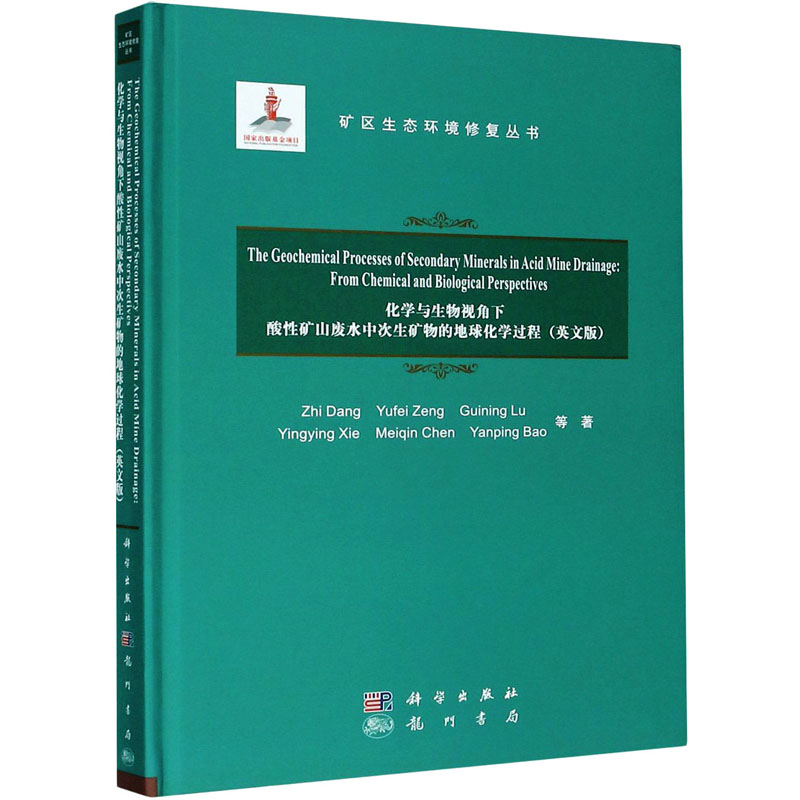内容简介
酸性矿山废水(Acid Mine Drainage,AMD)污染是矿产资源开发利用过程中金属硫化物自然风化产生的重要环境问题。AMD中所含的重金属等污染物经污灌进入矿山周边农田耕地,严重破坏矿区的生态环境,对农产品安全构成潜在的威胁。在AMD污染的流域环境中,常常也会形成的大量亚稳定的含铁硫酸盐次生矿物,能够对流域内的重金属起到吸附和共沉淀的作用,但同时也面临着矿物转化过程中重金属再释放的环境风险,影响着水体中重金属的环境行为与归宿。本书介绍以黄铁矾和施氏矿物为代表的次生矿物在多种环境因子介导下的生物化学转化过程以及重金属释放机制等科学问题。将有助厘清矿区重金属的迁移规律和内在机理,从而为矿区重金属污染防控和治理提供理论指导。本书适合从事矿区生态修复治理相关的企事业单位、科研机构、学生及对矿山生态环境有兴趣的大众人群。
展开▼
图书目录
Chapter 1 Pollution of Acid Mine Drainage in The Mining Area
1.1 Acid Mine Drainage and Its Occurrence
1.2 Mechanism of AMD Generation
1.3 AMD Prevention and Control Techniques
1.3.1 Oxygen Barrier
1.3.2 Bactericide
1.3.3 Co-Disposal and Blending
1.3.4 Passivation
1.3.5 Passive Treatment Techniques
1.4 Main Points of Interest in This Book
1.4.1 Sulfur Cycle in AMD-Affected Watershed
1.4.2 Fe Cycling and Nano-Fe(III) secondary minerals in AMD-Affected Watershed
1.4.3 Main Points of Interest inOurWork
1.5 The Dabaoshan Mine
1.5.1 Mineral Resources of The Dabaoshan Mine
1.5.2 Solid Waste Disposal in the Mine Area
1.5.3 AMD Control and Its Treatment in Mine Area
1.5.4 AMD Pollution in the Dabaoshan Mine Area
1.5.5 General Sampling Sites Arrangement
Chapter 2 Sulfate Migration and Geochemical Behaviors in the AMD-Affected River
2.1 Physicochemical Characteristics of the Affected River Watershed
2.1.1 Acidic Watershed Environments
2.1.2 High Turbidity
2.1.3 Steep Riverbed Upstream
2.1.4 Oxidative Water Condition
2.1.5 High Salinity
2.2 Sulfur Element Distribution in the Watershed
2.2.1 Dissolved Sulfur in Water Phase
2.2.2 Sulfur Distributions in Sediments
Chapter 3 Metallic Elements’ Fate and Migration Mechanisms in the AMD-Affected River
3.1 Metallic Elements in the Watershed
3.1.1 Dissolved Metallic Elements in the Water Phase
3.1.2 Metallic Elements in Sediment Phase
3.2 Migration Mechanisms for Metallic Elements in the Affected Watershed
3.2.1 Potential Mobility
3.2.2 Oxidative Leaching and Re-Adsorption
3.2.3 Hydraulic Transportation
3.2.4 Precipitation/ Co-Precipitation
3.3 Relations of Sulfur, Iron, and Metallic Elements in the Watershed
3.3.1 Relationship Argumentation by SPSS Analysis
3.3.2 Relationship Argumentation by Mineralogy Analysis
3.3.3 Relationship Argumentation via Isotope Analysis
Chapter 4 Microbial Community Composition in AMD-Polluted Watershed and Paddy Soil
4.1 Microbial Community Shifts in Response to AMD Pollution in the Hengshi River Watershed
4.1.1 Materials and Methods
4.1.2 Physicochemical Characterization of the Watershed
4.1.3 Alpha Diversity Analyses
4.1.4 Beta Diversity Analyses
4.1.5 Spatiotemporal Dynamics of Microbial Communities
4.2 Microbial Community Responses to AMD-Laden Pollution in Rice Paddy Soils
4.2.1 Investigating the Effect of Pollution inAMD-Affected Paddy Soil
4.2.2 Microbial Community and Soil Properties
4.2.3 The Spatial Pattern of Microbial Community
Chapter 5 Chemical Transformations of Secondary Minerals in the AMD-Affected Area: Induced by Dissolved Organic Matter
5.1 Role of L-Tryptophan in the Release of Chromium from Schwertmannite
5.1.1 Experimental Setting
5.1.2 Results and Discussion
5.1.3 Possible Mechanism
5.2 Fulvic Acid Induction of the Liberation of Chromium From CrO24 -Substituted Schwertmannite
5.2.1 Release of Total Fe, Cr, and SO24- from Schwertmannite
5.2.2 Cr Speciation Analysis
5.2.3 Proposed Schematic Illustrating Fate of Fe and Cr
5.3 Elucidation of Desferrioxamine B on the Liberation of Chromium from Schwertmannite
5.3.1 Dissolution Kinetics
5.3.2 Effects of DFOB and pH on the Dissolution of Cr-Schwertmannite
Chapter 6 Chemical Transformations of Secondary Minerals in AMD-Affected Area: Induced by Inorganic Substance
6.1 Effect of Cu(II) on the Stability of Oxyanion-Substituted Schwertmannite
6.1.1 Schwertmannite Synthesis
6.1.2 Stability Experiments
6.1.3 Effect of Cu(II) on the Stability of Oxyanion-Substituted Schwertmannite
6.2 Transformation of Cadmium-Associated Schwertmannite and Subsequent Element Repartitioning Behaviors
6.2.1 Cd-associated Schwertmannite Synthesis
……
展开▼
